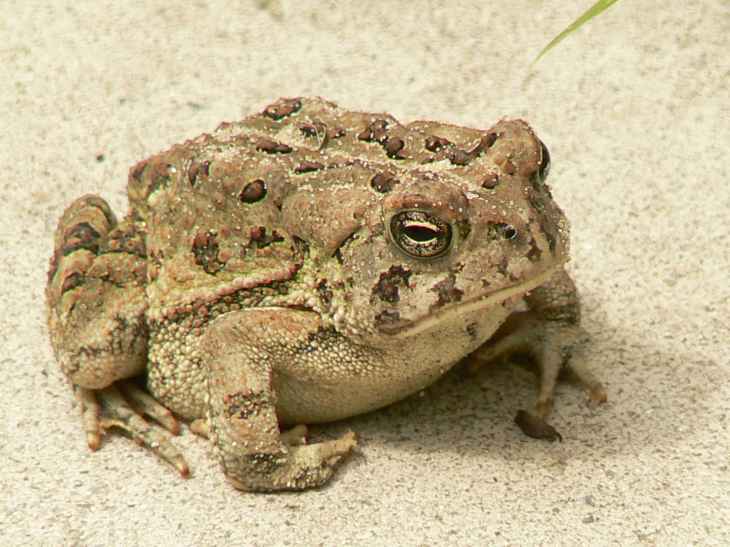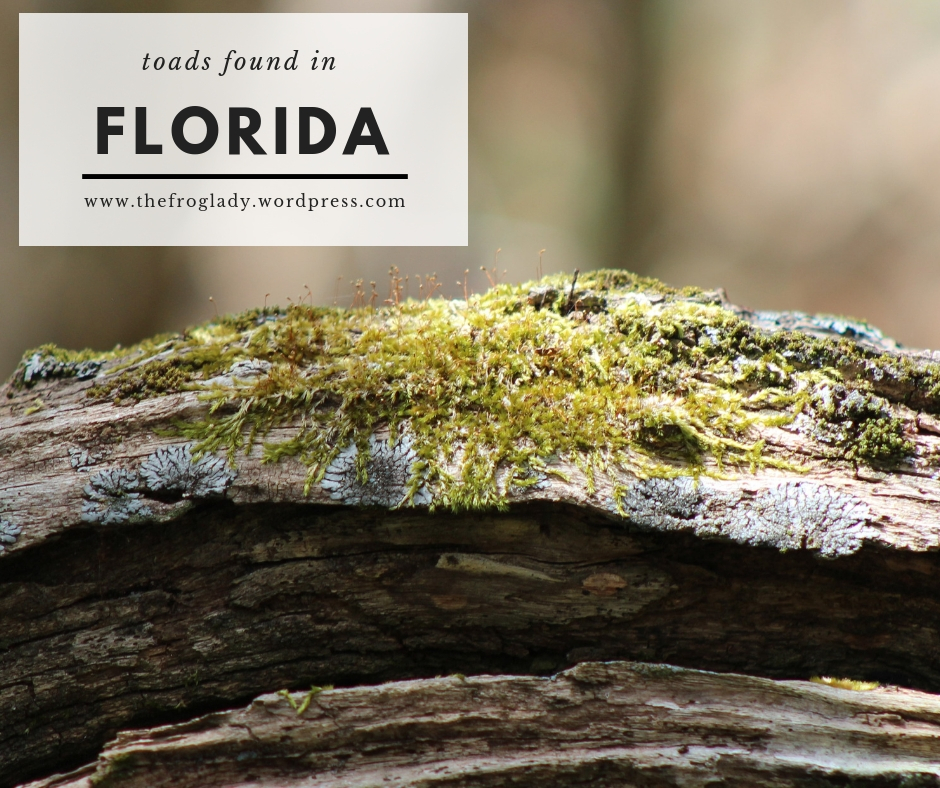***This post is a part of my series where this year I will be highlighting all of the different states native frogs and toads. Check out this page to see all of the United State’s native frogs broken down by state. ***
Due to the large number of native frogs and toads within Florida I have decided it to be easiest to split it into 3 sections: Frogs, Treefrogs and Toads. This is part 3 so here are the native toads to Florida.
Toads
Cane Toad (Rhinella marina)
The cane toad is considered an invasive species within the state of Florida. Report any sightings outside of range to tadpole@ufl.edu.

The cane toad is the largest toad in Florida – typically they will remain less than 6″ however they can reach up to 9.5″ in length. The body is tan to reddish-brown and back is marked with dark spots. They are found primarily in urbanized habitats but also can be found in floodplains and mangrove swamps.

Male calls with a melodic trill March through September. Listen to the call below.
Eastern narrow mouth toad (Gastrophryne carolinensis)**
**Although it bears the name of “toad” it is actually considered to be a frog.

This frog is typically 1″ in length, with females being slightly larger. One defining characteristic of this frog is the fold of skin on the back of the frogs head. The eastern narrow mouth toad is grey or brown in color with smooth thick skin. It can be found in grassy areas on rocky slopes and in rock filled canyons. They will hide under rocks and can sometimes be found with tarantulas. As shown in the photo below, they can be found across the state of Florida.

The male eastern narrow mouth toad’s belly will create a substance that will stick the mating pair together. The female will lay up to 850 eggs on the surface of the water. They will take 2 days to hatch and will be toadlets within a quick 30-60 days. It’s call sounds similar to a bleating sheep with a baaaaa. Several calling frogs together sound like bees or a bunch of toy airplanes. I was very surprised by the pitch of their call. Have a listen below:
Eastern Spadefoot (Scaphiopus holbrookii)

The Eastern Spadefoot has smoother and more moist skin than most toads and is speckled with very tiny warts. This species typically had a light brown to yellow brown color mottled with dark brown. The back of the eastern spadefoot may be dark brown with exception of a couple light yellow stripes. The lines are usually more visible in males. The Eastern Spadefoot has a vertical pupil in the eye similar to a cat. They can be found in the sandy soil along the floodplains of streams and rivers. The Eastern Spadefoot prefers dry habitats with sandy soil, but will breed in flooded fields or ditches in warm rainy weather. They can be found throughout Florida except for in a few southern counties.

These spadefoots spend almost all of their time buried under ground, with the exception of breeding time. During breeding time, the spadefoots emerge from their burrows and the male will let out a short explosive “wank” call which sounds like a call of a crow. Something odd about these guys is that some people believe that the Eastern spadefoot smells like peanut butter.
Fowler’s Toad (Anaxyrus fowleri)

The Fowler’s toad is usually brown, grey, olive green and rust red in color with darkened warty spots. As these toads become adults, a pale stripe will form down its back. The belly is usually white-ish with one dark spot. These toads are found throughout the Florida panhandle.

This toad has a long, loud, high pitched W-A-A-A-H-H-H call. Listen to it in the video below! It is said that they can be mistaken for a herd of sheep calling in the night. The Fowler’s toad will make a series of quick, short hops as the American toad will make a few larger hops. The Fowler’s toad will amplexus in June& July. The female can release 7,000 -10,000 fertilized eggs which will hatch 2-7 days later.
https://www.youtube.com/ezHxi2DEHOE
Oak Toad (Anaxyrus quercicus)

The Oak Toad is the smallest toad in North America – reaching 1.75″ in length. They are so small that they were originally classified as half-grown southern toads. They are typically black or brown in color with a white, cream or yellow stripe on the back. They have 4-5 pairs of dark colored blotches on the back as well. The bumps on their back tend to have a red, orange or brown color which gives it a rough texture. Their stomach is grayish white. They can be found in grassy areas or areas with sandy soil or freshwater wetlands. In Florida, they can be found throughout the state.

The oak toad has a chirping call which can be heard from April – October. The females will lay 300-500 eggs in a strand attached to grass. The call can be heard below:
Southern Toad (Anaxyrus terrestris)

The southern toad is typically 3″ in length and is more often brown, but can be black, grey or red. It lives in areas with sandy soils and spends its days in its burrow.

Breeding occurs in spring when males migrate from their upland habitats to the swamps, ditches and pools to breed. Each female may lay up to 4,000 eggs which will take up to 55 days to morph into juvenile frogs. Listen to the males call below:
Thanks for reading! Check out all of the state’s native frogs and toads here.

Photo Credits:
Cover photo used by the creative commons license. Text was added. See Original photo by Monikah Schuschu here.
- Photo from Flickr Wikimedia Commons used under the Creative Commons license. Photo taken by Sam Fraser-Smith. Original Photo Here.
- Photo from Flickr Wikimedia Commons used under the Creative Commons license. Photo taken by Rusty Clark. Original Photo Here.
- Photo from Connecticut Department of Energy & Environmental Protection. Original photo here.
- Photo from Wikipedia Commons used under the Creative Commons license. Photo taken by Perlick Laura. Original Photo Here.
- Photo from Flickr Wikimedia Commons used under the Creative Commons license. Photo taken by Bob Peterson. Original Photo Here.
- Photo from Flickr Wikimedia Commons used under the Creative Commons license. Photo taken by tom spinker. Original Photo Here.
Like “The Frog Lady” on facebook or follow aapanaro on instagram to get some sneak peeks into the frog lady’s frog room!


2 thoughts on “Florida Toads”